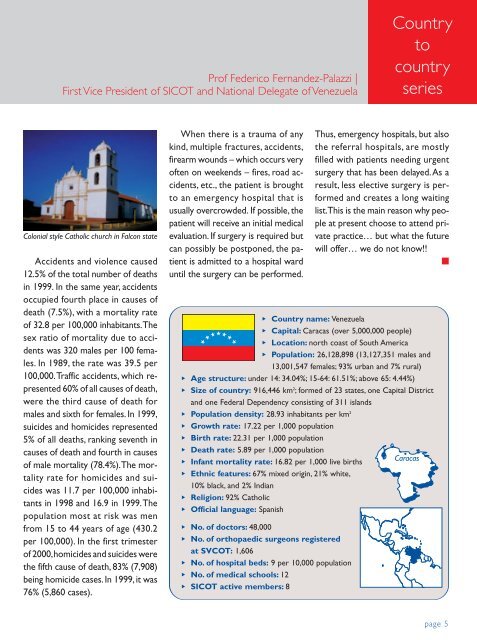Orthopaedic Surgeryin VenezuelaIn Venezuela, medicalstudies can be undertakenin <strong>the</strong> following<strong>of</strong>ficial universities:Central University <strong>of</strong>Caracas (UCV) with 2 medical campuses,one at <strong>the</strong> Razzetti school locatedin <strong>the</strong> University City and <strong>the</strong>o<strong>the</strong>r at <strong>the</strong> Vargas School locatedin <strong>the</strong> north-west <strong>of</strong> Caracas;OrientUniversity, situated in <strong>the</strong> easternpart <strong>of</strong> <strong>the</strong> country, with differentcampuses in Barcelona, Cumana,Maturin and Ciudad Bolivar;AndesUniversity (ULA) in Merida and SanCristobal; Carabobo University(CU) in Valencia and Maracay; Center-OccidentalUniversity (UCO-LA) (Lisandro Alvarado) in Barquisimeto;Zulia University (LUZ) in Maracaibo,<strong>the</strong> second most populatedcity; Francisco de Miranda University(FMU) located in Coro. All <strong>of</strong><strong>the</strong>m are government-owned universities.After medical studies have beencompleted, <strong>the</strong> graduate must doone year <strong>of</strong> rural medicine and <strong>the</strong>ngo to an accredited hospital to receivetrauma training. A specialtymust be done in an accredited certifiedhospital and lasts for threeyears.These hospitals ei<strong>the</strong>r belongto universities, <strong>the</strong> Social SecurityInstitute (IVSS), <strong>the</strong> Government, or<strong>the</strong> Municipalities.Very few are private.Trainingconsists mainly <strong>of</strong> traumaand adult orthopaedics withlittle paediatric orthopaedics.Afterending <strong>the</strong> three-year training, <strong>the</strong>graduate can ei<strong>the</strong>r apply for a certifiedsubspecialty in Hand Surgeryor Paediatric Orthopaedics or do aone- or two-year Fellowship in,among o<strong>the</strong>r things,Arthroscopy,Foot and Ankle, Spine, or EmergencyTrauma. Due to its proximity,most graduate orthopaedic surgeonsgo to <strong>the</strong> United States forFellowships and a smaller numbergo to Europe.Thus, in terms <strong>of</strong> specialisttraining, <strong>the</strong> influence <strong>of</strong> <strong>the</strong>United States is more importantthan that <strong>of</strong> Europe.The number <strong>of</strong> orthopaedic surgeonsregistered at <strong>the</strong> “SociedadVenezolana de Cirugía Ortopédicay Traumatología” (SVCOT), <strong>the</strong>national Trauma and OrthopaedicSociety, is 1,606, according to lastyear’s records. SVCOT has differentgrades <strong>of</strong> membership.There areAn Andean valley387 Adherent members, who areresidents or starting to practise;1073 Effective members, who havehad less than six years in practice;276 Associate members, with morethan six years in practice; 93 Titularmembers, with more than 12 yearsin practice and after having presentedwork in a General Assembly; 36Honorary members, who are awardedthis membership according to<strong>the</strong>ir curriculum after outstandingpractice; and finally 70 Jubilee members,who are retired orthopaedicsurgeons and traumatologists.In 1997, <strong>the</strong> population withsome form <strong>of</strong> insurance reached15,665,235 (65% <strong>of</strong> <strong>the</strong> total population).57% <strong>of</strong> <strong>the</strong>m belonged to<strong>the</strong> IVSS.The National Health Ministry(MSDS) takes care <strong>of</strong> about80% <strong>of</strong> <strong>the</strong> population. Despite <strong>the</strong>fact that public hospitals should<strong>the</strong>oretically be capable <strong>of</strong> <strong>of</strong>feringsufficient health services, part <strong>of</strong><strong>the</strong> population relies on being treatedat private hospitals or clinicsfor reasons such as long waitinglists, unsatisfactory treatments,overcrowded hospitals, lack <strong>of</strong> certainmedication and surgical items,inoperative X-ray machines, laboratories,etc.These are problems outsidedoctors’ control.Thus, qualifiedspecialist work can be found in both<strong>the</strong> public and private health sectoror only in private practice.page 4
Pr<strong>of</strong> Federico Fernandez-Palazzi |First Vice President <strong>of</strong> <strong>SICOT</strong> and National Delegate <strong>of</strong> VenezuelaCountrytocountryseriesColonial style Catholic church in Falcon stateAccidents and violence caused12.5% <strong>of</strong> <strong>the</strong> total number <strong>of</strong> deathsin 1999. In <strong>the</strong> same year, accidentsoccupied fourth place in causes <strong>of</strong>death (7.5%), with a mortality rate<strong>of</strong> 32.8 per 100,000 inhabitants.Thesex ratio <strong>of</strong> mortality due to accidentswas 320 males per 100 females.In 1989, <strong>the</strong> rate was 39.5 per100,000.Traffic accidents, which represented60% <strong>of</strong> all causes <strong>of</strong> death,were <strong>the</strong> third cause <strong>of</strong> death formales and sixth for females. In 1999,suicides and homicides represented5% <strong>of</strong> all deaths, ranking seventh incauses <strong>of</strong> death and fourth in causes<strong>of</strong> male mortality (78.4%).The mortalityrate for homicides and suicideswas 11.7 per 100,000 inhabitantsin 1998 and 16.9 in 1999.Thepopulation most at risk was menfrom 15 to 44 years <strong>of</strong> age (430.2per 100,000). In <strong>the</strong> first trimester<strong>of</strong> 2000,homicides and suicides were<strong>the</strong> fifth cause <strong>of</strong> death, 83% (7,908)being homicide cases. In 1999, it was76% (5,860 cases).When <strong>the</strong>re is a trauma <strong>of</strong> anykind, multiple fractures, accidents,firearm wounds – which occurs very<strong>of</strong>ten on weekends – fires, road accidents,etc., <strong>the</strong> patient is broughtto an emergency hospital that isusually overcrowded. If possible, <strong>the</strong>patient will receive an initial medicalevaluation. If surgery is required butcan possibly be postponed, <strong>the</strong> patientis admitted to a hospital warduntil <strong>the</strong> surgery can be performed.Thus, emergency hospitals, but also<strong>the</strong> referral hospitals, are mostlyfilled with patients needing urgentsurgery that has been delayed.As aresult, less elective surgery is performedand creates a long waitinglist.This is <strong>the</strong> main reason why peopleat present choose to attend privatepractice… but what <strong>the</strong> futurewill <strong>of</strong>fer… we do not know!!■u Country name: Venezuelau Capital: Caracas (over 5,000,000 people)u Location: north coast <strong>of</strong> South Americau Population: 26,128,898 (13,127,351 males and13,001,547 females; 93% urban and 7% rural)u Age structure: under 14: 34.04%; 15-64: 61.51%; above 65: 4.44%)u Size <strong>of</strong> country: 916,446 km 2 ; formed <strong>of</strong> 23 states, one Capital Districtand one Federal Dependency consisting <strong>of</strong> 311 islandsu Population density: 28.93 inhabitants per km 2u Growth rate: 17.22 per 1,000 populationu Birth rate: 22.31 per 1,000 populationu Death rate: 5.89 per 1,000 populationu Infant mortality rate: 16.82 per 1,000 live birthsCaracasu Ethnic features: 67% mixed origin, 21% white,10% black, and 2% Indianu Religion: 92% Catholicu Official language: Spanishu <strong>No</strong>. <strong>of</strong> doctors: 48,000u <strong>No</strong>. <strong>of</strong> orthopaedic surgeons registeredat SVCOT: 1,606u <strong>No</strong>. <strong>of</strong> hospital beds: 9 per 10,000 populationu <strong>No</strong>. <strong>of</strong> medical schools: 12u <strong>SICOT</strong> active members: 8page 5






